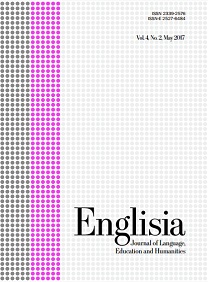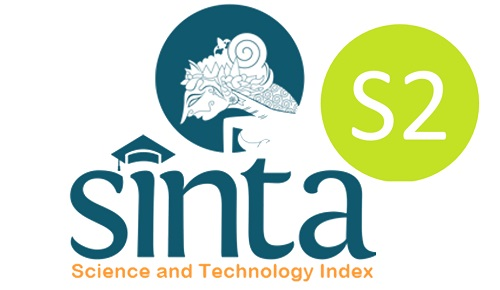The effect of YouTube videos with immersive learning strategy on young learner speaking performances
DOI:
https://doi.org/10.22373/ej.v12i2.26004Keywords:
Immersive Learning Strategy, YouTube video, speaking, individual learning, pair learningAbstract
This study seeks to evaluate the impact of YouTube videos incorporating an immersive learning strategy on the speaking performance of young learners. It is designed as a quantitative research project. The participants consist of all fifth-grade students at Islamic Primary School 6 Banda Aceh during the 2023/2024 academic year, totaling 40 students—20 engaged in pair learning and 20 in individual learning. A random sampling method was implemented using Google Forms. Data collection involved an oral pre-test and post-test or interview as the primary instrument. The data were analyzed statistically with the Wilcoxon signed-rank test to determine the p-value for four speaking skills. The results revealed a sig 2-tailed value of 0.000 for all four items, falling below the 0.05 significance level. This indicates that YouTube videos with an immersive learning strategy significantly influenced the speaking performance of young learners, particularly in expressing personal needs. These findings carry pedagogical implications for EFL teachers, encouraging the use of YouTube videos to improve students’ speaking abilities. The results can guide teachers and curriculum designers in choosing and organizing learning activities to optimize language development outcomes through a student-centered approach.Downloads
References
Abbas, N. M., & Qassim, T. A. (2020). Investigating the effectiveness of YouTube as a learning tool among EFL students at Baghdad university. Arab World English Journal, 696, 344-356. https://dx.doi.org/10.24093/awej/call6.23.
Abugohar, M. A., Al-Hnifat, M. A., Al-Smadi, O. A., Rashid, R. A., & Yunus, K. (2019). English Language Speaking Skill Issues in an EMP Context: Causes and Solutions. International Journal of English Linguistics, 9(3), 211–225. https://doi.org/10.5539/ijel.v9n3p211.
Alberta Education. (2010). French language education services: Handbook for French immersion administrators. Alberta Education. https://open.alberta.ca/dataset/3d93080b-bd08-4d2e-b1f2-43838371e740/resource/9e8b75a0-013b-4c9a-9c1d-dc02d489b41b/download/french-language-education-services-handbook.pdf.
Ary, D., Jacobs, L. C., Irvine, C. K. S., & Walker, D. A. (2019). Introduction to Research in Education (10th Ed.). Boston: Cengage.
Aziz, A. A., & Kashinathan, S. (2021). ESL Learners’ Challenges in Speaking English in Malaysian Classroom. International Journal of Academic Research in Progressive Education and Development, 2(10), 983–991. http://dx.doi.org/10.6007/IJARPED/v10-i2/10355.
Balbay, S., & Kilis, S. (2017). Students' Perceptions of the use of a YouTube channel specifically designed for an Academic Speaking Skills Course. Eurasian Journal of Applied Linguistics, 3(2), 235-251. http://dx.doi.org/10.32601/ejal.461003.
Brown, H. D. (2004). Language assessment: Principles and classroom practices. New York: Longman.
Brown, G., & Yule, G. (2007). Teaching the spoken language: An approach based on the analysis of conversational English. United Kingdom: Cambridge University Press.
Chen, Z. (2019). An Exploration of Immersion English Teaching Model. Journal of Language Teaching and Research, 10(2), 423-431. http://dx.doi.org/10.2991/ecss-19.2019.95.
Chen, H. C., & Yang, Y. J. (2021). The Impact of Interactive Technologies on Language Immersion Programs. Computer Assisted Language Learning, 34(4), 482-503.
Chien, C. W. (2016). Taiwanese EFL undergraduates’ self-regulated learning with and without technology. Innovation in Language Learning and Teaching, 13(1), 1–16. https://doi.org/10.1080/17501229.2016.1264076.
Egbert, J., & Shahrokni, S. A. (2018). CALL Principles and Practices. Open Text Washington State University. https://opentext.wsu.edu/call/.
Ghonsooly, B., & Elahi, N. (2015). "The Difficulties of Young EFL Learners in Speaking English: A Case Study of Iranian Elementary School Students." International Journal of Applied Linguistics & English Literature, 4(6), 107-115.
Gibbons, J. D., & Chakraborti, S. (2011). Nonparametric statistical inference (5th ed.). Boca Raton: Chapman and Hall/CRC.
Jackson, C. K. (2022). Assessing the Impact of Achievement Tests on Educational Outcomes: A Comprehensive Review. Educational Policy Analysis Archives, 30(1), 89-104.
Harianja, N., & Fibriasari, H. (2019). YouTube as the learning media to improve the speaking skill in expression oral course. Asian Themes in Social Sciences Research, 1(3), pp. 14-17.
Hasan, M. M., Ibrahim, F., Mustapha, S. M., Islam, M. M., & Younus, M. A. A. (2018). The use of YouTube videos in learning English language skills at tertiary level in Bangladesh. Infrastructure University Kuala Lumpur Research Journal, 6(1), 27-34.
International Baccalaureate Organization. (2020). Middle Years Program Language Acquisition Guide. United Kingdom: Cardiff.
Ismaili, M. (2013). The effectiveness of using movies in the EFL classroom: A study conducted at South East European University. Academic Journal of Interdisciplinary Studies, 2(4), 121-132. http://dx.doi.org/10.5901/ajis.2012.v2n4p121.
Marneni, S., et.al. (2017). Developing speaking skills of graduates in rural Telangana: An experimental study with task-based activities. International Journal of Instruction, 89-92.
Matthews, B., & Ross, L. (2010). Research methods: A practical guide for the social sciences. London: Pearson Education.
Mei, L. L., & Masoumeh, A. (2017). An Analysis of Factors Influencing Learners’ English Speaking Skill. International Journal of Research in English Education, 1(2), 34–41.
Mujianto, H. (2019). Pemanfaatan YouTube sebagai media ajar dalam meningkatkan minat dan motivasi belajar. Jurnal Komunikasi Hasil Pemikiran dan Penelitian, 1(5), 135-159. http://dx.doi.org/10.10358/jk.v5i1.588.
Muslem, A., & Abbas, M. (2017). The effectiveness of immersive multimedia learning with peer support on English speaking and reading aloud. International Journal of Instruction, Vol. 1, 203-218, 1308-1470. http://dx.doi.org/10.12973/iji.2017.10113a.
Muslem, A., Mustafa, F., Usman, B., & Rahman, A. (2017). The application of video clips with small group and individual activities to improve young learners’ speaking performance. Teaching English with Technology (TEwT), 17(4), 25-37, 1642-1027.
Muslem, A., Zulfikar, T., Ibrahim, I. H., Syamaun, A., Saiful, & Usman, B. (2019). The Impact of Immersive Strategy with English Video Clips on EFL Students' Speaking Performance: An Empirical Study at Senior High School. Teaching English with Technology, 19 (4), 90-103, 1642-1027.
Nguyen, T., & Chan, R. (2022). The role of interactive simulations in developing language skills: A study of VR applications in EFL classrooms. Computers & Education, 177, 104340. https://doi.org/10.1016/j.compedu.2021.104340.
Porter, S., & Castillo, M. S. (2023). The Effectiveness of Immersive Language Learning: An Investigation into English Language Acquisition in Immersion Environments Versus Traditional Classroom Settings. Research Studies in English Language Teaching and Learning, 1(3). https://doi.org/10.62583/rseltl.v1i3.18.
Soelistya, D., Juhadi, Rahmi, S., Priyatiningsih, N., Siregar, M., Supriatna, U., & Saputra, N. (2023). The Effect of Immersive Learning on Students’ Cognitive and Affective Aspect. Journal of Studies in Media and Communication, Redfame, 11(5), 79-84.
Sudaryono, Margono, G., & Rahayu, W. (2013). Pengembangan instrument penelitian. Yogjakarta: Graha Ilmu.
Sudjana, Nana. (2009). Penilaian Hasil Proses Belajar Mengajar (Cet. 14). Bandung: Remaja Rosdakarya.
Suryani, I., Pratiwi, N. P. A., & Suarnajaya, I. W. (2020). Investigating the Inhibiting Factors in Speaking English Faced by Senior High School Students in Singaraja. International Journal of Language Education, 4(1), 48–58. https://doi.org/10.26858/ijole.v4i2.10054.
Tallinn, M. (2005). An introduction to immersion. In T. Talliin (Ed.), Immersion handbook (pp. 3-4). Publishing House.
Wang, Q., & Xu, W. (2023). Immersive learning environments and language acquisition: Insights from recent research. Computers & Education, 182, 104456. https://doi.org/10.1016/j.compedu.2022.104456.
Downloads
Published
Issue
Section
License
Copyright (c) 2025 Siti Zuhra, Asnawi Muslem, Muhammad Aulia

This work is licensed under a Creative Commons Attribution 4.0 International License.
Proposed Policy for Journals That Offer Open Access
Authors who publish with Englisia journal agree to the following terms:
- Authors retain copyright and grant the journal right of first publication with the work simultaneously licensed under a Creative Commons Attribution License that allows others to share the work with an acknowledgement of the work's authorship and initial publication in this journal.
- Authors are able to enter into separate, additional contractual arrangements for the non-exclusive distribution of the journal's published version of the work (e.g., post it to an institutional repository or publish it in a book), with an acknowledgement of its initial publication in this journal.
- Authors are permitted and encouraged to post their work online (e.g., in institutional repositories or on their website) prior to and during the submission process, as it can lead to productive exchanges, as well as earlier and greater citation of published work (See The Effect of Open Access).









